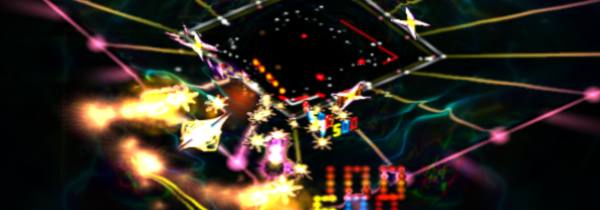Wot I Think: Space Giraffe
Upon its X-Box 360 release, Space Giraffe was the most critically divisive game of 2007. Scan down those Metacritic scores. Those reviewers who slammed it – like Xbox US which gave it 2/10 and dismissed it as "damn-near-unplayable technoslop" - were openly mocked as weakling idiots by Jeff Minter's devotees. Others, like Eurogamer, split the difference and did a dual review. In the end, the hailing didn't matter – it simply didn't sell. That hasn't stopped its accolades building up. Stuart Campbell – who remains the world's sharpest critic of arcade games – said it was “one of the best games released this year at any price”. No less than Braid-creator Jonathan Blow described it as “the arcade game analogue of Ulysses”. So – much-praised-yet-ignored underdog comes to the PC. And this is RPS. And I'm me.
It's inevitable I'm going to like it, yeah?
Yeah, it seems so. I like it a lot. Which is something of a surprise.
On Monday, when I first decided the previous few paragraphs were going to be my intro, the reveal was “Actually, no. I don't like it at all”. In the time since – and me wanting to examine my response in detail is why I haven't got around to posting about either the demo or the full game until now - it's gone the other way. The game unfolded, or at least my head did. It's now it's own creature and it's something that a good chunk of you will adore. And the others will blow chunks.
(The “you either love-it/hate-it” line's turned up in quite a few Space Giraffe reviews. I'm not sure whether that's actually true. I think it's more of a question whether you can stand it for long enough to love it. It's easy to reject. In fact, it's easy to reject for perfectly reasonable reasons. And I suspect that if it wasn't Minter who wrote it, people would have. But more on that later.)
Space Giraffe is built on top of Tempest's structure. It doesn't really play like Tempest – which, for me, is good as it's the gamer's-game early eighties arcade classic which has never really moved me – but its scoring system and play style are quite divorced. There's lots to it, but the basics involve manipulation of what's called the Power-Zone. Hitting enemies (and a few other things) makes the power zone expand up the map away from you. When it's in existence, you're able to barge enemies who've climbed to the outer ring off, shoot to either side rather than just directly down the grid and it slows down enemy projectiles passing through it. When it's not in existence... well, you're in trouble, really. You better get it back as soon as you can. Barging (“bulling”) enemies off en masse is how you power up your multiplier, which you'll want to do as otherwise the game will mock your scoring ability. Other main things to consider are your ability to leap off the grid when you pick up one-charge power-pods and a smart-bomb-a-life. And there's lots more stuff too.
(I'd suggest you head off to Campbell's piece if you want a fuller breakdown of the mechanics. I've got other fish to fry.)
The second thing you'll notice about Space Giraffe is that it really is a Llamasoft game. Jeff Minter was one of the first developers you could call an Auteur in all seriousness, and his hoof-prints are all over Space Giraffe (For the uninitiated, Minter's vision is basically: ungulates + early eighties arcade game + lysergic Graphic Effects). We have music-responsive psychadelic graphical effects. We have English-whimsy text messages (“Top Hole!”). We have nods at whatever pop cultural elements that took his fancy. We have – let's state the fucking obvious – a game called Space Giraffe. This is the stuff which most quickly lost the people who hate the game – specifically, the incredibly intense graphic effects of the 360 version. You couldn't see what's happening, claimed the antis. That's fine – you're meant to use the sound effects to locate yourself and (er) use the force, claimed the pros.
The problem here – as it is in the best of arguments – is that both sides are right.
It's also a problem that you only have to face on the PC if you choose to. The biggest change between the two versions is that... well... there's two versions. The main 100 levels of the game have been re-jigged to tame the random trippiness. However, they also include the originals as a full-on acid-experience for those who want such things effectively including twice as much content as before. Which is a clear plus. It's worth noting that the strimming back of the excesses doesn't actually mean that those people who rejected the game for it being confusing will be able to get it now. Partially because there's still a mass of information density on the screen, and you're still going to find yourself cursing at enemies who killed you, and you have no idea how. But mainly because the removal of the obvious information-hiding element of the game makes it clear exactly how much obfuscation is built into it elsewhere.
In short, the game does a phenomenally bad job at explaining how it works. Especially early on, the deaths from not seeing what's happening are actually deaths about not realising how the enemies work. Even the basic enemy types are left unexplained in-game, requiring a trip to a FAQ or trial-and-error (and probably multiple trials-and-errors before you work out what's actually happening and why you died and/or won. Introduction of the enemies which you can't actually bull off the grid are a good example of that). More so, while the major rules remain, the details of how they operate can change on a level for level basis. Is this one where the Power Zone shrinks quickly or slowly? Is this one where the flowers grow really quickly and hang around before exploding or is it one where they're slow and pretty much invulnerable? Fuck knows until you go in there, and if it's a sudden and violent change, you need to throw lives onto the sacrifice pyre of the great god of the arcades.
So, when playing, fighting my way through new level after level was hellishly frustrating. It was openly horrible. I hated it.
That's the point I'd reached when I was about to write about Space Giraffe on Monday. But I decided to play a little more before pulling the trigger and as I grabbed my controller and started shooting, I felt something click inside my head. It was working. It's a good game. Hell, it may even be a great one.
The key thing: I wasn't playing the levels that were making me scream the previous day. I'd just started from the beginning, replaying the earlier ones whose rules I understood and how they were tweaked on each level. I wasn't playing just to get through. I was playing to play well. Or, at least, reasonably well.
You unlock new levels, the natural urge is to start at those levels. That is totally fatal. You will cry. Beating a level isn't the point. Mastering the level is the point.
(Well... mostly the point. There's some levels – and I haven't completed half of the 100, let alone the unlockable ones – which are just cliff-faces followed by a mass of reasonable ones. I'll skip those and ride the slopes afterwards, thankyouverymuch. Especially when you get into the middle thirties, and the beautifully graphic-distorting ones show up. The new version walks the line between graphical wonderment and playing bemusement perfectly there.)
The sense of mastering it is also helped by one of the cuter mechanics buried in the game. Complete a level with three lives and if you restart the game from the next level, assuming you beat it, you get given whatever score you had when you started it. In other words, you can build a score from across all the levels without having played all the levels in one go. And if you're three-life-ing any given level, it's a good sign you should press on and break new ground.
And then the game will beat you around a bit, and you'll beat it back, and you'll both be the better for it.
The key of Space Giraffe is that for something that appears initially such a twitch-based game, it's actually a strategic experience. It's a game about managing crowds, creating safe-places and other higher-level thought patterns that don't require dodging between streams of bullets. It's its own game, and in its own way, a triumph. You should try the demo, and realise that if you don't like it, you could be wrong.
That's why this overview of a game I really like has been so negative – because it's a game which doesn't explain itself at all, so I think it's served best by someone else walking through how miserable it may make you you play, and then say what's the quickest way past it. It's a game good enough that I don't mind being awkwardly down about it, if you see what I mean.
There is that nagging question though. As much as I like Space Giraffe, you wonder exactly how something as simple as a game about shooting can manage to be so fundamentally inaccessible.
That Jonathan Blow guy? Totally right.
A couple of other thing which sits outside the actual critique of the game as a game.
Firstly, as I mentioned earlier, there is the sense that if it wasn't Minter doing it, I wouldn't have persisted to crack open the game's shell and gorge myself on its fleshy innards. In the Symposium I'm involved with, the topic of whether you approach a game equally depending on who it's made turned up. It shouldn't make a difference. But it does. Minter – and Valve and whoever else – have earned that tiny benefit of the doubt. It's totally not fair for the new indie kid making an awkward game... but I don't think there's anything we can do about it.
Secondly, there's another aspect that you may find somewhat grating with Space Giraffe. The 360 release was for 400 microsoft points. That is, about five dollars. The PC version is twenty dollars.
Yes, the PC version includes many more levels including the possibility of expanding with more in the future. Yes, the 360 version was probably deeply underpriced, especially for what's clearly an arcade game that only a niche will want to consume. Yes, the 360 version didn't sell, so the experience must have taught Llamasoft that they should release at higher price or risk starvation. Yes, the standard price for a PC Indie game is basically twenty dollars. And – most importantly – yes, it's totally worth twenty dollars.
But there's something that sits awkwardly that the PC version is four times as much as the basically identical 360 one. And more so, that you can assume half the money goes to Microsoft from the 360 one while all the money on the PC direct-download goes straight to Llamasoft. Much like a sudden death on a level you haven't quite grasped yet, it doesn't seem fair.
I'd strongly urge you to play the demo. I'd urge you, if you do, to persist on the demo and try and get good at it. And if it clicks, I'd at least consider buying it. It's its own creature and simply one of the finest works in Minter's long career.
Also: KLF sound-sample. MU! MU! MU! M! Fuck yeah, y'know?




